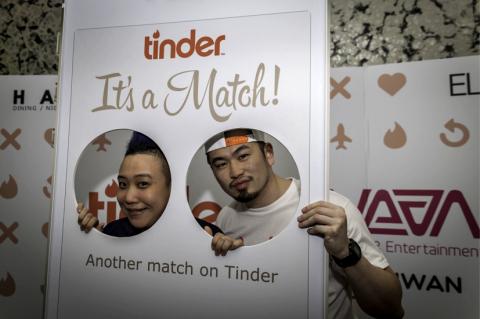Leanne McGoolsby first downloaded Tinder, the app that matches people based on mutual swipes, a few years ago in Taiwan. At first, she would go on dates with interesting people outside of her circles or those that were just visiting Taiwan for a short time. Eventually, she became involved in a relationship and did not need to use the app anymore.
After McGoolsby’s relationship fizzled out, she decided to try out the dating scene once again. This time, though, she got messages on Tinder that were somewhat off-putting and borderline creepy. One read, “I’ve got the little spoon position available for hire. What would you rate your cuddling abilities on a scale of 1 to 10?”
Another guy’s first pick-up line was, “I am a gentle man. I am here to love you.” McGoolsby then decided Tinder was not for her. “There are a lot of weirdos out there,” she said.

Photo courtesy of Jamie Mactography
Staff reporter Dana Ter was a first-time Tinder user and a skeptic. She had only heard horror stories about meeting people through dating apps, but still decided to give it a try. The first guy she matched with, she went to meet for a drink at 1am. After their date, Ter thought she would never see him again because it was Tinder and the guy was using the app to hook up while he was backpacking around the world. Surprisingly, though, Ter and her new boyfriend were soon inseparable and found themselves on the verge of something special.
LIFESTYLE APP
Tinder describes itself as a location-based social discovery app that helps mutually interested parties communicate with each other. When the app is mentioned casually in conversations though, a lot of people think Tinder is the way to find no-strings-attached one night stands nearby.

Photo courtesy of Tinder
According to Tinder spokesperson Evan Bonnstetter, this is far from the truth.
“Calling Tinder a hook-up app is a misconception. In fact, the vast majority of our users are looking to form meaningful, long-term relationships through Tinder. Tinder is for dating, friendships, marriage and everything in between,” Bonnstetter said.
An US Securities and Exchange Commission (SEC) filing which went public last month reported that Tinder had 9.6 million users by September. This means that there are a lot of people swiping left and right and looking for someone special. Now, Tinder is aiming to take on Taiwan by looking to connect people through their behaviors.

Photo courtesy of Jamie Mactography
Bonnstetter believes that Tinder has plenty of potential in Taiwan.
“Taiwan is in Tinder’s top 40 countries globally and in our top five markets in Asia,” he said.
To push into the Taiwan market, Tinder is sponsoring various nightlife activities such as ladies’ nights at clubs and the recently completed tour of the hip-hoppers, Far East Movement.
The plans are not just for when the sun goes down, though. Soon Tinder will be doing pop-up fitness classes in different areas of Taiwan as well as other events that match people through their lifestyle instead of just swiping right.
IS TRUE LOVE POSSIBLE ON TINDER?
McGoolsby says that finding soul mates on Tinder is possible. “Loads of my friends have met their significant others on there,” she said.
While Ter has experienced finding love on Tinder, she thinks that she is one of the lucky ones.
“If Tinder is solely based on looks and making quick judgments on people by having to swipe right or left based on their initial pictures, then it’ll be hard for it to move away from being primarily a hook-up app,” she said.
Ter believes that matching people through lifestyle choices is a good idea, but she doesn’t think that would make Tinder much different from Match.com or eHarmony, both dating Web sites that charge users. She thinks it is really up to the individual users to find the best way to use Tinder.
“I’ve had some guys message me saying they’re just looking for a fuck buddy, and other times, it ends up being a relationship. It’s all about chance really,” she said.

Cheng Ching-hsiang (鄭青祥) turned a small triangle of concrete jammed between two old shops into a cool little bar called 9dimension. In front of the shop, a steampunk-like structure was welded by himself to serve as a booth where he prepares cocktails. “Yancheng used to be just old people,” he says, “but now young people are coming and creating the New Yancheng.” Around the corner, Yu Hsiu-jao (饒毓琇), opened Tiny Cafe. True to its name, it is the size of a cupboard and serves cold-brewed coffee. “Small shops are so special and have personality,” she says, “people come to Yancheng to find such treasures.” She

In July of 1995, a group of local DJs began posting an event flyer around Taipei. It was cheaply photocopied and nearly all in English, with a hand-drawn map on the back and, on the front, a big red hand print alongside one prominent line of text, “Finally… THE PARTY.” The map led to a remote floodplain in Taipei County (now New Taipei City) just across the Tamsui River from Taipei. The organizers got permission from no one. They just drove up in a blue Taiwanese pickup truck, set up a generator, two speakers, two turntables and a mixer. They

Former Chinese Nationalist Party (KMT) chairwoman Hung Hsiu-chu’s (洪秀柱) attendance at the Chinese Communist Party’s (CPP) “Chinese People’s War of Resistance Against Japanese Aggression and the World Anti-Fascist War” parade in Beijing is infuriating, embarrassing and insulting to nearly everyone in Taiwan, and Taiwan’s friends and allies. She is also ripping off bandages and pouring salt into old wounds. In the process she managed to tie both the KMT and the Democratic Progressive Party (DPP) into uncomfortable knots. The KMT continues to honor their heroic fighters, who defended China against the invading Japanese Empire, which inflicted unimaginable horrors on the

Hannah Liao (廖宸萱) recalls the harassment she experienced on dating apps, an experience that left her frightened and disgusted. “I’ve tried some voice-based dating apps,” the 30-year-old says. “Right away, some guys would say things like, ‘Wanna talk dirty?’ or ‘Wanna suck my d**k?’” she says. Liao’s story is not unique. Ministry of Health and Welfare statistics show a more than 50 percent rise in sexual assault cases related to online encounters over the past five years. In 2023 alone, women comprised 7,698 of the 9,413 reported victims. Faced with a dating landscape that can feel more predatory than promising, many in